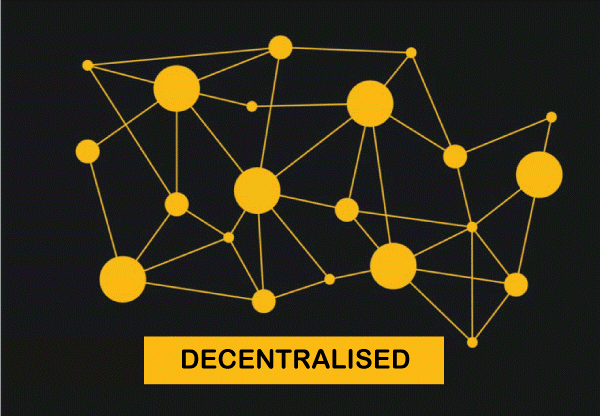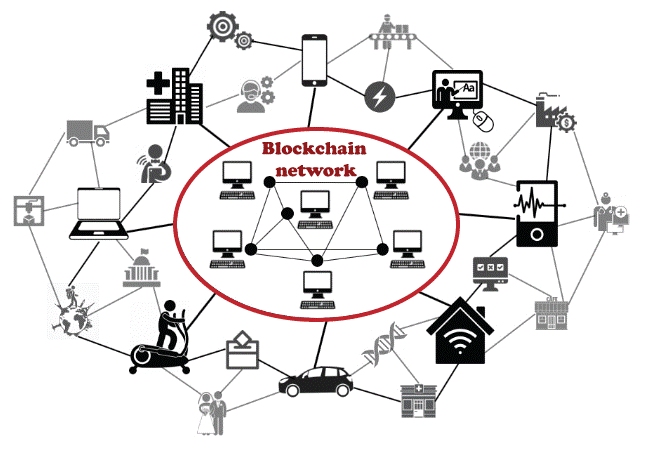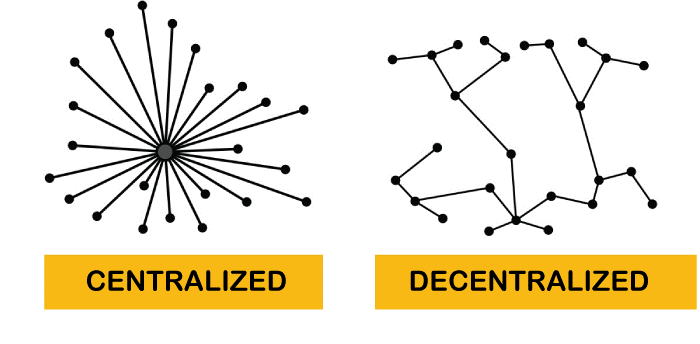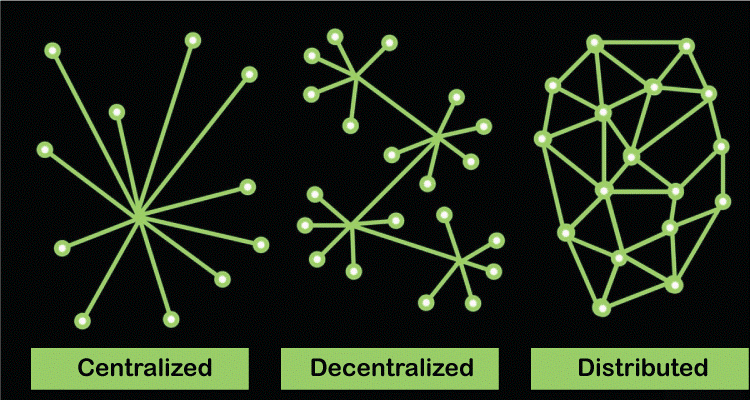What is Decentralized System?
A decentralized system is a system where there is no single point of control or authority. Instead, control is distributed among the participants in the system, often through a network of nodes that communicate and collaborate with each other.

In a decentralized system, each participant has some degree of autonomy and can make decisions independently while still adhering to a set of rules or protocols that govern the system's overall behavior. This makes the system more resilient because it is less vulnerable to single points of failure or attack.
Decentralized systems are commonly used in blockchain technology, where multiple nodes work together to maintain a distributed ledger of transactions. This eliminates the need for a central authority, such as a bank, to verify and record transactions, and enables a more secure and transparent way of conducting transactions.
Importance of Decentralized System
Decentralization has many important benefits, including:
- Increased Resilience: Decentralized systems are more resilient to failures, attacks, and other disruptions because they do not rely on a single control point. Instead, control is distributed among many nodes, which can continue to operate even if some nodes are taken offline or compromised.
- Increased Security: Decentralized systems are generally more secure than centralized systems because they are more difficult to attack or manipulate. A centralized system has a single point of failure that attackers can exploit. In contrast, a decentralized system distributes control among many nodes, making it harder for any one node to compromise the system.
- Greater Transparency: Decentralized systems are often more transparent than centralized systems because all participants can access the same information. In a decentralized blockchain system, for example, all nodes have access to the same ledger of transactions, which makes it difficult to manipulate or conceal information.
- Increased Trust: Decentralized systems can increase participants' trust by eliminating the need for a centralized authority to mediate transactions or enforce rules. Instead, the rules are enforced by the network of nodes, which can be more trustworthy because they are not motivated by profit or self-interest.
- Greater Privacy: Decentralized systems can provide greater privacy than centralized systems because they do not rely on a centralized authority to collect and store personal data. Instead, data can be stored locally on individual nodes or encrypted to protect privacy.
Working of Decentralized System
The working of a decentralized system can vary depending on the specific application and technology used, but here are some general steps involved in a decentralized system:
- Distributed Network: A decentralized system is typically based on a distributed network of nodes connected to each other through a communication protocol. These nodes can be computers, servers, or other devices that share data and processing power.
- Consensus Mechanism: To maintain the system's integrity, decentralized systems often use a consensus mechanism to ensure that all nodes agree on the same information. For example, nodes compete to solve a complex mathematical problem in a blockchain system. The first node to solve the problem is rewarded with the ability to add a new block of transactions to the blockchain.
- Decentralized Database: The data in a decentralized system is typically stored in a decentralized database spread across multiple network nodes. This ensures that no single node has complete control over the data and makes the system more resilient to attacks and failures.
- Smart Contracts: Many decentralized systems use smart contracts, which are self-executing contracts with the terms of the agreement written into code. Smart contracts can automate many aspects of a decentralized system, such as enforcing rules and executing transactions.
- User Interaction: Users of a decentralized system can interact with the system through various interfaces, such as a web-based interface or a mobile app. These interfaces allow users to view and interact with the system's data, execute transactions, and interact with smart contracts.
Is Decentralized System Secure?
Decentralization can increase security in many cases, but it does not guarantee safety.
Decentralized systems can be more secure than centralized systems because they are more difficult to attack or manipulate. A centralized system has a single point of failure that attackers can exploit. In contrast, a decentralized system distributes control among many nodes, making it harder for any one node to compromise the system.
However, decentralized systems can still be vulnerable to attacks or vulnerabilities in the underlying technology or protocol. For example, a blockchain system can be susceptible to a 51% attack if a single entity controls more than 50% of the network's computing power.
Decentralization does not necessarily guarantee the security or privacy of the data stored in the system. The safety and privacy of a decentralized system depend on the specific implementation and the measures taken to protect the data.
Disadvantages of Decentralization
Decentralization can provide many advantages, but it can also have some disadvantages, including:
- Increased complexity: Decentralization can increase complexity by distributing control among many nodes, making it more difficult to manage and maintain the system.
- Slower decision-making: Decentralization can lead to slower decision-making because it can require more consensus-building among the nodes. This can be a disadvantage in situations where quick decision-making is critical.
- Lack of standardization: Decentralization can result in a lack of standardization because each node can operate independently and use different protocols or standards. This can make it more difficult to integrate and standardize the system.
- Higher implementation costs: Decentralization can have higher implementation costs because it can require more resources to set up and maintain the system. This can be a disadvantage for organizations with limited resources.
- Security vulnerabilities: Decentralization can create new security vulnerabilities because each node in the system can be a potential target for attacks. This can require additional security measures and resources to protect the system.
- Limited scalability: Decentralization can have limited scalability because each node in the system must be able to communicate and process transactions. This can be a disadvantage when the system needs to handle a large volume of transactions.
Uses of Blockchain in Decentralization
Blockchain is a distributed ledger technology that is often used to enable decentralization. Here are some of how blockchain can be used in decentralization:

- Decentralized transactions: Blockchain can be used to enable decentralized transactions, such as peer-to-peer payments, without the need for intermediaries like banks.
- Smart contracts: Blockchain can be used to execute smart contracts, which are self-executing contracts with the terms of the agreement written into code. Smart contracts can be used to automate processes and eliminate the need for intermediaries.
- Decentralized applications: Blockchain can be used to build decentralized applications, which run on a decentralized network of computers rather than a centralized server. This can increase security, privacy, and transparency.
- Decentralized identity: Blockchain can be used to create decentralized identity systems, enabling users to control their identity data and eliminating the need for centralized identity providers.
- Supply chain management: Blockchain can be used to enable decentralized supply chain management, where every participant in the supply chain can see and verify the history of a product.
- Decentralized voting: Blockchain can enable secure and transparent decentralized voting systems, eliminating the need for centralized election authorities.
Application of Decentralized System
Decentralized systems are becoming increasingly popular as they offer several advantages over traditional centralized systems. Some of the main applications of decentralized systems include:
1) Cryptocurrencies: Cryptocurrencies like Bitcoin, Ethereum, and many others are built on decentralized blockchain technology. Decentralization ensures that no single entity or authority controls the currency, making it resistant to censorship and fraud.
2) File sharing: Decentralized file-sharing networks like BitTorrent and IPFS allow users to share files without relying on a centralized server. This makes file sharing faster, more efficient, and less susceptible to censorship or shutdown.
3) Voting systems: Decentralized voting systems use blockchain technology to ensure election transparency and security. They eliminate the need for intermediaries, reduce the possibility of fraud, and provide a more secure and trustworthy way to conduct elections.
4) Supply chain management: Decentralized supply chain management systems use blockchain technology to track products from their origin to the end-user. This ensures transparency and accountability and reduces the possibility of fraud or counterfeiting.
5) Social media: Decentralized platforms like Steemit, Minds, and Mastodon give users more control over their data and eliminate the need for a central authority to moderate content.
6) Cloud computing: Decentralized cloud computing platforms like Golem and iExec use blockchain technology to allow users to rent out their unused computing power to others in a secure and decentralized manner.
Is WWW a Decentralized System?
No, the World Wide Web (WWW) is not a decentralized system. The WWW is a collection of interconnected centralized servers that are controlled by various organizations and entities, such as governments, corporations, and individuals. When a user requests information from the WWW, the request is sent to a centralized server, which then responds with the requested information.
While the WWW has enabled access to vast information and transformed how we communicate and conduct business, it is not decentralized. This centralization can lead to issues such as censorship, data breaches, and monopolies. However, efforts are underway to create decentralized alternatives to the WWW, such as the Solid project, which aims to create a decentralized web where users control their data and identity.
Centralized vs. Decentralized System

Centralized and decentralized are two different ways to organize systems or networks. In a centralized system, a single entity or authority controls all the decision-making and resource allocation. In contrast, decision-making and resource allocation are distributed among multiple entities in a decentralized system.
For example, a centralized government has a single authority that makes decisions and manages resources for the entire country. On the other hand, a decentralized government, such as a federation, has multiple sources that make decisions and manage resources for their respective regions.
In technology, a centralized system may refer to a scenario where a single entity, such as a server or company, controls data or computing power. In contrast, a decentralized approach may be where data or computing power is distributed among multiple nodes or devices, such as a peer-to-peer network.
Both centralized and decentralized systems have their advantages and disadvantages. Centralized systems may be more efficient in decision-making and resource allocation but may also be more vulnerable to attacks or failures. Decentralized systems may be more resilient and secure but may also be slower and more complex to manage.
In recent years, decentralized technologies such as blockchain have gained popularity due to their potential to provide secure and transparent systems without a central authority.
Decentralized vs. Distributed System

Decentralized and distributed systems are two similar but distinct concepts. Both types of systems involve the distribution of resources or decision-making across multiple nodes, but the key difference between them is how this distribution is achieved.
In a distributed system, the resources or decision-making power is spread out among multiple nodes, but each node operates independently and makes its own decisions. There is no central coordinator or authority that controls the system. Examples of distributed systems include peer-to-peer networks and some forms of cloud computing.
In contrast, in a decentralized system, the nodes work together to make decisions and manage resources, but no single node has control over the entire system. Instead, decisions are made by consensus among the nodes. Decentralized systems are often used to create secure, transparent systems without a central authority. Examples of decentralized systems include blockchain technology and some forms of decentralized finance.
A distributed system is one where nodes work independently without a central authority, while a decentralized system is one where nodes work together to make decisions. Still, there is only one node that has control over the entire system. Both approaches have advantages and disadvantages, and the choice of which kind of system to use depends on the application's specific requirements.
There is often an overlap between decentralized and distributed systems, and the two concepts are not mutually exclusive. Some plans may be both decentralized and spread, such as some blockchain networks, where nodes work together to create a consensus-based system, but each node operates independently and holds a copy of the blockchain ledger. Similarly, some distributed systems may have some degree of centralization, such as a cloud computing system where a central authority manages the allocation of resources. Still, the resources are distributed across multiple nodes. The terms "decentralized" and "distributed" are often used interchangeably, but it's important to understand the nuances of each concept to describe and evaluate different systems accurately.